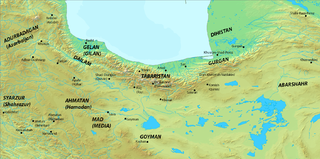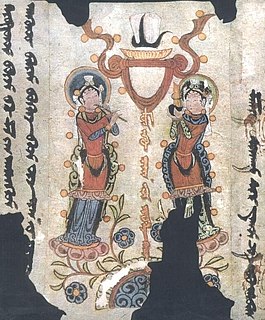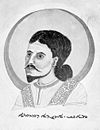Related Research Articles

Manichaeism is a former major religion founded in the 3rd century CE by the Parthian prophet Mani, in the Sasanian Empire.

Mani was an babylonian prophet and the founder of Manichaeism, a religion most prevalent in late antiquity strongly influenced by Gnosticism, Christianity, Zoroastrianism, and Buddhism, which was once widespread but is now confined to small areas of China, such as Fujian.

Eleutheropolis, was a Roman and Byzantine city in Syria Palaestina, some 53 km southwest of Jerusalem. Its remains still straddle the ancient road connecting Jerusalem to Gaza and are now located within the Beit Guvrin National Park.
Akouas was an important figure in early Manichaeism. He has been identified with another Manichaean figure from Iranian sources named Mar Zaku.
The Shabuhragan, which means "dedicated to Šābuhr", also translated in Chinese as the Chinese: 二宗经; pinyin: Erzongjing; lit. 'Text of Two principles' was a sacred book of the Manichaean religion, written by the founder Mani himself, originally in Middle Persian, and dedicated to Shapur I, the contemporary king of the Sassanid Persian Empire. This book is listed as one of the seven treatises of Manichaeism in Arabic historical sources, but it is not among the seven treatises in the Manichaean account itself. The book was designed to present to Shapur an outline of Mani's new religion, which united elements from Zoroastrianism, Christianity, and Buddhism.

Asoristan was the name of the Sasanian province of Assyria and Babylonia from 226 to 637.

Abarshahr or Nishapur was a Sasanian satrapy (province) in Late Antiquity, that lay within the kust of Khorasan. The province bordered Media in the west, Hyrcania in the north west, Margiana in the north east, and Harev in the south east. The governor of Abarshahr is attested to have held the unique title of kanarang, distinguished from the title of marzban given to governors of frontier provinces. Abarshahr came to be known as one of the nicknames of the city of Nishapur which was considered to be the capital city of the province of Abarshahr during the Sassanian period and later on.
Buddhologist Edward Conze (1966) has proposed that similarities existed between Buddhism and Gnosticism, a term deriving from the name Gnostics, which was given to a number of Christian sects. To the extent that Buddha taught the existence of evil inclinations that remain unconquered, or that require special spiritual knowledge to conquer, Buddhism has also qualified as Gnostic.

Mar Ammo was a 3rd-century Manichean disciple of the prophet Mani. According to Manichaen tradition he spread Manichaeism eastward into Sogdiana during the time period when Mani was living. Mar Ammo is well known as the apostle of the east in Manichean literature nevertheless his exact origins are unknown. His Syriac name may denote that he was Aramaic in origin. However, a Parthian origin may also be seen and is mentioned by some scholars, especially due to his outstanding role in establishing the Parthian language as the official language of the eastern Manichean Church, later to be replaced by Sogdian in the sixth century. Furthermore, Mar Ammo is widely regarded as the composer of the Manichaean Parthian hymn-cycles.
Agapius was a philosopher associated with Manichaeism. He is believed to have lived in the fourth or fifth century.

Cao'an is a temple in Jinjiang, Fujian, Luoshan Subdistrict. Originally constructed by Chinese Manicheans, it was considered by later worshipers as a Buddhist temple. This "Manichean temple in Buddhist disguise" is seen by modern experts on Manichaeism as "the only extant Manichean temple in China", or "the only Manichean building which has survived intact". In 2021, Cao'an was inscribed on the UNESCO World Heritage List along with many other sites near Quanzhou because of its unique testimony to the exchange of religious ideas and cultures in medieval China.
Chinese Manichaeism or ‘Religion of Light’ known as Monijiao (Chinese: 摩尼教; pinyin: Móníjiào; Wade–Giles: Mo2-ni2 Chiao4; lit. 'religion of Moni') or Mingjiao (Chinese: 明教; pinyin: Míngjiào; Wade–Giles: Ming2-Chiao4; lit. 'religion of light' or 'bright religion'), is the form of Manichaeism transmitted and practiced in China. It rose to prominence during the Tang dynasty and, despite frequent persecutions, continued long after the other forms of Manichaeism were eradicated in the West. The most complete set of surviving Manichaean writings were written in Chinese sometime before the 9th century and were found in the Mogao Caves among the Dunhuang manuscripts.
The Treasure of Life is one of the seven treatises of the prophet Mani, written and regarded as part of the major canon of Manichaeism. The title is possibly derived from Christ's parable of the hidden treasure from Matthew 13:44, which is followed by the parable of the pearl in Matthew 13:45–46; incidentally, pearls are a major metaphor used in Mani's teaching. Also, the Syriac title, Simath Hayye, is identical with the name of an uthra in Mandaeism called Simat Hayyi.
Manichaean scripture includes nine main books: the Seven Treatises of Manichaeism, all personally written by Mani in Syriac, the Shabuhragan written by Mani in Middle Persian, and the Arzhang, a series of illustrations painted by Mani.
The Epistles is one of the Seven Treatises of Manichaeism. It is derived from the Middle Ancient Persian dēwān, which means "Letter Collection". They have been long known among Manichaean scriptures They were originally written during the years of Mani’s public mission in the Sasanian Empire. They were collected together by his followers and became one of the canonical books of the Manichaean community It served a purpose of explaining the doctrine and arguing for the correctness of Manichaeism

In Manichaeism, Jesus is considered one of the four prophets of this religion, along with Zoroaster, Gautama Buddha and Mani. He is also a "guiding deity" who greets the light bodies of the righteous after their deliverance.
Mar Sisin, the letter of the last thought, also known as Sisinnius, one of the twelve Apostles of the founder of Mani. He was one of the most influential Manichaeans in the early church, as he served as a core figure of the early church and was the first Manichaean Archegos, the head of the Manichaean religion.
Mar Adda, was one of the twelve apostles of Mani, the founder of Manichaeism, the year of birth and death is unknown.

Although Manichaeism was a fairly unified religious phenomenon, it had some schisms over its history. These schisms occurred from the sixth century AD until at least the 10th century AD.
The Archegos was the head of the Manichaean religion. No surviving list of every Archegos remains, and the succession procedure is unknown. Abū Hilāl al-Dayhūri is the last known Archegos. The first Archegos was the prophet Mani.
References
- ↑ Michel Tardieu. Manichaeism. tran. MB DeBevoise. Urbana 111; University of Illinois Press, c2008.
- ↑ Lieu, Samuel N.C. Manichaeism in the Later Roman Empire and Medieval China: a Historical Survey. Pages 68-69. Manchester University Press, 1985.
- ↑ Cologne Mani Codex, p. 165.6; see ``Zeitschrift für Papyrologie und Epigraphik V, 1970, p. 111, n. 32
- ↑ Andreas-Henning, Mir. Man. II, p. 301ff.
- Asmussen, Jes Peter (1985), "Mār Ammō", Encyclopedia Iranica, vol. I, Costa Mesa: Mazda Press.
